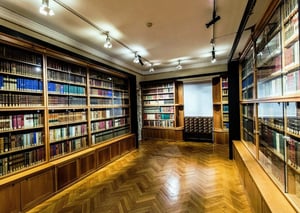The “Livia Simoni” library is annexed to the Teatro alla Scala museum, set up at the same time as the museum with a nucleus of about 10,000 volumes of history and theatrical criticism and musical scores. In 1954 with the testamentary bequest of the theater critic and playwright Renato Simoni the library increased its entire collection of 40,000 volumes; in memory of the critic’s mother, the library was named after Livia Simoni. Two further large collections then flowed into the library, that of the actor Ruggero Ruggeri (acquired by the Cassa di Risparmio of the Lombard Provinces and donated to the museum) and that of the writer Arnaldo Fraccaroli , donated by his son.
Today the library’s library heritage consists of over 150,000 which make it one of the most important libraries for the richness and completeness of the collections in the theater, opera, music and dance fields. Rare volumes from the sixteenth century relating to representations of sacred and profane themes and pastoral tales , illustrated editions of valuable seventeenth century and a large number of autographed and annotated specimens are part of the bibliographic patrimony .
At its inception in 1913, the museum included a library of around 10,000 volumes, largely of criticism, theatrical history, scores and musical biographies.
Archive
The library at the second floor of the Museum is dedicated to Livia Simoni preserves wonderful volumes on the world of music, dance and theater. The library opened in 1913, when the museum was inaugurated, and it boasted some 10,000 volumes.
The archive section of the library preserves large collections of sketches of sets, theatrical figures, photographs, posters and posters, opera librettos, letters from actors, directors, composers and singers who over time have collaborated with the Teatro alla Scala since the century. XVII to our days. There are also numerous handwritten musical scores by Giuseppe Verdi , Gioachino Rossini , Giacomo Puccini and Gaetano Donizetti . There are also some musical manuscripts of complete works including: Giuseppe Verdi’s Requiem Mass and Gioachino Rossini’s Tancredi , as well as scattered pages and sketches by Mozart, Beethoven, Puccini, Donizetti, Bellini.
In the early fifties, the bequest of Renato Simoni, of 54,000 volumes, increased the collection of the library which, from the date of the subsequent inauguration, took the name of “Livia Simoni”, in memory of the mother, for a precise testamentary will.
Over the years, the donation of the books by Ruggero Ruggeri and Arnaldo Fraccaroli followed, which brought the collection to considerable dimensions (over 150,000 volumes) and placed it among the most important in Italy and in the world for its sector of expertise.
The oldest volume contains the comedies of Plautus, printed in Venice by Lazzaro Soardi in 1511. The sixteenth century are 363, often in editions of rare value; there are more than 400 works of the seventeenth century, while the collection of volumes of the following centuries is very rich. The archive is annexed to the library, which includes 2,255 sketches, 6,959 sketches, 3,000 theatrical posters, 6,000 opera librettos, 10,300 autograph letters of actors, directors, composers and singers, 30 musical manuscripts of complete works (including the Mass from Verdi ‘s Requiem and Rossini’s Tancredi ) and 300 scattered sheets (with pages by Verdi, Rossini, Donizetti, Puccini, Beethoven), 7,000 photographs and 10,000 engravings.
The oldest volume in the library is an edition of the works of Tito Maccio Plauto published in Venice in 1511 by Lazzaro Soardo. The first catalogue of the Museum is part of the collection. It was published one year after its inauguration. It shows on its cover a miniature by Quaglia depicting the singer Giuseppina Grassini. Teatro Alla ScalaLIbretto for the first performance of the opera La Gioconda, music by Amilcare Ponchielli
Teatro alla Scala Museum
The Museum is actually located between via Filodrammatici and Piazza della Scala, in a lateral wing of the historic building designed by Giuseppe Piermarini.
The current construction, dating back to 1831, was designed by Giacomo Tazzini and replaced the so-called “Casino dei Nobili”, built according to Piermarini’s design at the same time as La Scala. This complex is still known today as “Casino Ricordi”. Indeed, the famous music publishing house was located here for many years.
The first nucleus of the museum was established in 1911 with the purchase at a Parisian auction of the private collection of the Parisian antiquarian Giulio Sambon , a great fan of theater . The purchase was made possible thanks to a public subscription and a government allocation. The subscription fee was 5,000 lire at the time, a considerable figure, which is close to 15,000 euros today. The collection was intended to document the history of the show from antiquity to modernity, initially without a relationship with the specific activity of the Teatro alla Scala. The museum was officially inaugurated on March 8, 1913.
In the following years many donations and acquisitions were added to the initial nucleus of the collection. During the Second World War the collections were moved to safe places for safekeeping and at the end of the war, after the reconstruction, the museum was rearranged by Fernanda Wittgens . The exhibition area of the museum consists of fourteen rooms and exhibits marble busts and portraits of numerous composers , conductors and artists of the European musical field of the last two centuries, ancient musical instruments. Some paintings depict the Teatro alla Scala.







